Using a dryer outlet to charge your Tesla is technically possible, but it is not the ideal solution. Dryer outlets typically provide 240V power, which is compatible with Tesla's charging requirements. However, these outlets are not designed for continuous use with electric vehicles and may pose safety risks, including overloading the circuit and potential electrical hazards. For safe and efficient charging, it is recommended to install a dedicated EV charging station or a dedicated 240V outlet.
What Are the Specific Charging Requirements for a Tesla?
Tesla Charging Levels: Tesla vehicles can be charged using different levels of charging:
-
Level 1 Charging: Utilizes a standard 120V outlet, providing a slow charge suitable for overnight charging but not ideal for daily use.
-
Level 2 Charging: Requires a 240V outlet and provides a faster charge, making it suitable for regular home use. This level is often necessary for efficient daily charging of EVs.
Voltage and Amperage Requirements: For effective Level 2 charging, a Tesla requires a 240V outlet with at least 30 amps of current. The outlet must provide sufficient power to ensure the battery charges at an optimal rate.

What Are the Safety Considerations for Using a Dryer Outlet?
Using a dryer outlet to charge a Tesla can be a convenient option, but it’s essential to consider various safety factors to ensure a secure and reliable charging setup. Here are the primary safety considerations to keep in mind:
Electrical Load and Compatibility
Capacity of Dryer Outlets: Dryer outlets are typically rated at 240V and 30 amps, which matches the requirements for Level 2 charging. However, it's crucial to verify that the outlet and circuit are capable of handling the continuous load of a Tesla charger. Ensure that the dryer outlet's wiring and circuit breaker are rated for the electrical load required by your Tesla charger.
Proper Wiring: The wiring connected to the dryer outlet must be in good condition and appropriately sized for the electrical load. Faulty or outdated wiring can pose significant safety risks, including potential overheating or electrical fires.
Potential Overheating Issues
Risk of Overloading: Using a dryer outlet for Tesla charging can increase the risk of overloading, particularly if other high-power appliances are also used on the same circuit. Overloading can lead to overheating, which might result in electrical fires or damage to the outlet.
Monitoring Temperature: Regularly monitor the temperature of the dryer outlet and the charging equipment during use. If you notice any unusual warmth or signs of overheating, it’s crucial to address the issue immediately to prevent potential hazards.
Adapter Use
Quality and Compatibility: If you use an adapter to connect your Tesla charger to the dryer outlet, ensure that the adapter is high-quality and compatible with both the outlet and the Tesla’s charging requirements. Using a substandard or incorrect adapter can create safety risks, including electrical faults or fires.
Regular Inspection: Periodically inspect the adapter and connection for signs of wear or damage. Replace any components that show signs of deterioration to maintain a safe charging environment.
Compliance with Electrical Codes
Local Regulations: Ensure that using a dryer outlet for Tesla charging complies with local electrical codes and regulations. These codes are designed to ensure safety and prevent potential electrical hazards. Failure to adhere to these codes could result in unsafe conditions and legal issues.
Professional Evaluation: Consider having a licensed electrician evaluate your dryer outlet setup. An electrician can verify that the installation meets all safety standards and recommend any necessary upgrades or modifications.
By addressing these safety considerations, you can help ensure that using a dryer outlet for Tesla charging is both effective and secure. Proper attention to electrical load, wiring, adapter quality, and compliance with regulations will mitigate potential risks and contribute to a safer charging experience.
What Are the Potential Risks and Disadvantages?
Using a dryer outlet to charge your Tesla presents several risks and disadvantages that should be carefully considered.
Charging Speed: Although a dryer outlet meets the voltage and amperage requirements for Level 2 charging, it might not offer the same efficiency as a dedicated EV charger. This can result in slower charging times, potentially impacting your ability to quickly and fully charge your vehicle.
Impact on Electrical System: Charging through a dryer outlet places an additional load on your home's electrical system. If the outlet shares the circuit with other high-power appliances or is not adequately designed to handle the extra load, it could strain the electrical system. This might lead to issues such as frequent breaker trips or necessitate costly upgrades to your electrical panel.
Long-Term Wear and Tear: Regular use of a dryer outlet for charging can accelerate wear and tear on both the outlet and the wiring. Over time, this can lead to deterioration and increased risk of electrical faults. The charging equipment may also experience stress, potentially affecting its reliability and lifespan.
Safety Concerns: Overloading the dryer outlet or circuit can result in overheating, which poses a risk of electrical fires. The use of adapters to connect the Tesla charger to the dryer outlet introduces additional variables that could affect safety. Low-quality or incompatible adapters can create electrical faults, further increasing safety risks.
Regulatory and Compliance Issues: Using a dryer outlet for EV charging may not always align with local electrical codes and regulations. Non-compliance can result in safety hazards and legal issues. Ensuring that your setup meets all regulatory requirements is essential to avoid potential problems.
Understanding these risks and disadvantages can help you evaluate whether using a dryer outlet is a suitable option or if a dedicated EV charging station would provide a safer and more efficient solution.
What Are the Alternatives to Using a Dryer Outlet for Charging My Tesla?
If you’re considering alternatives to using a dryer outlet for charging your Tesla, there are several options to explore that may offer improved efficiency, safety, and convenience.
Dedicated EV Charging Stations: Installing a Level 2 EV charging station at home is often the best alternative. These stations are specifically designed for electric vehicles and provide faster and more reliable charging compared to using a dryer outlet. They also include safety features and are built to handle the demands of regular use.
Dedicated 240V Outlet: Another option is to install a dedicated 240V outlet specifically for EV charging. This setup avoids the issues associated with sharing an outlet with other appliances and ensures that the outlet and circuit are optimized for EV charging. It provides a more straightforward and safer solution compared to adapting a dryer outlet. For efficient and reliable performance, the Autel NACS EV Charger is a recommended choice, as it is designed to work seamlessly with 240V outlets.
Public Charging Stations: Utilizing public charging stations is a practical alternative, especially if you frequently need to charge your Tesla away from home. Public chargers often offer faster charging speeds and can be found at various locations such as shopping centers, parking garages, and highway rest areas.
Portable EV Chargers: For flexibility, consider a portable EV charger that can be used with standard outlets or a dedicated 240V outlet. These chargers can be particularly useful if you need a charging solution that can adapt to different settings and charging needs.
Each of these alternatives provides different benefits in terms of charging speed, safety, and convenience. Evaluating these options based on your charging requirements and home setup can help you choose the most suitable solution for your Tesla.
Conclusion
Using a dryer outlet to charge a Tesla can be a temporary solution if it meets the technical and safety requirements. However, for optimal performance and safety, investing in a dedicated Level 2 charging station is recommended. A professional assessment and adherence to local electrical codes will help ensure that your charging setup is safe and efficient.
















Laisser un commentaire
Tous les commentaires sont modérés avant d'être publiés.
Ce site est protégé par hCaptcha, et la Politique de confidentialité et les Conditions de service de hCaptcha s’appliquent.